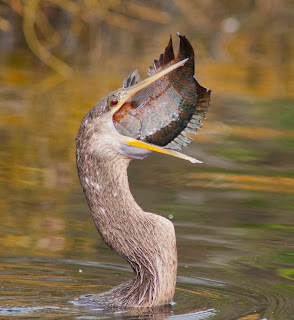Capturing an anhinga capturing its prey is hit or miss because they dart around the water quickly. But if you hit it just right after the bird surfaces with its prey, you sometimes will have several more seconds before it swallows the fish, giving you time to capture several images at high speed. The anhinga trail is also the location for several anhinga nests, such as the one below shot a couple years ago. The challenge with these is that the nests are mostly out of good view or light and have lots of messy twigs and branches getting in the way. Somehow, I managed to get this shot using flash as the sunlight was off to the side. You might also get lucky and capture the male partner in flight with nest branches.
On my visit today, I concentrated on the close-up shots because, well, that was about the only photo opp available. For these close-ups, often the bird is standing on the wooden barrier that runs along the paved trail. I typically sit on the ground and point upward in order to remove the distracting background which might include the visitor center's roof and various vegetation. The other issue I had today is that the bird faced away from me. To capture good light on the eye, I had to wait for the bird to turn its head back toward the camera, often times when it preened its wings. I love the anhinga's wing feathers and often try to include them in the image.
I stayed with the bird for awhile, as dozens of tourists passed closely, sometimes disturbing the bird but not enough for it to move. I went back and forth between horizontal and vertical, attempting to capture various compositions with a clean background. I used my fill flash and kept the aperture at f10 or 11. With close ups, a greater depth of field is preferred so as to get the entire bird in focus. Flash helps in these situations.
If you want instant gratification with bird photography, the Anhinga Trail is the place to be. But, it comes with a few challenges. Number 1: the wooden barrier gets in the way often for those low perspective shots. Number 2: there is a lot of messy background to deal with and lighting is a bit tricky in places. Number 3: after about 8 am, there are lots of tourists. And last but not least, the rubber-eating vultures. Right now, I am very agitated with the vultures for eating the rubber tubing that lines the rocker panels of my car. The little bastards were crazy in the parking lot at 7:30 am and going after exposed cars left and right. The park does provide tarps to cover your car, but they don't cover the rocker panels on my car. So I thought I would outsmart the birds and park on the roadway just before it enters the parking lot. Didn't work. But, I still enjoy photographing them, so here is one more image from the infamous Anhinga Trail.





































